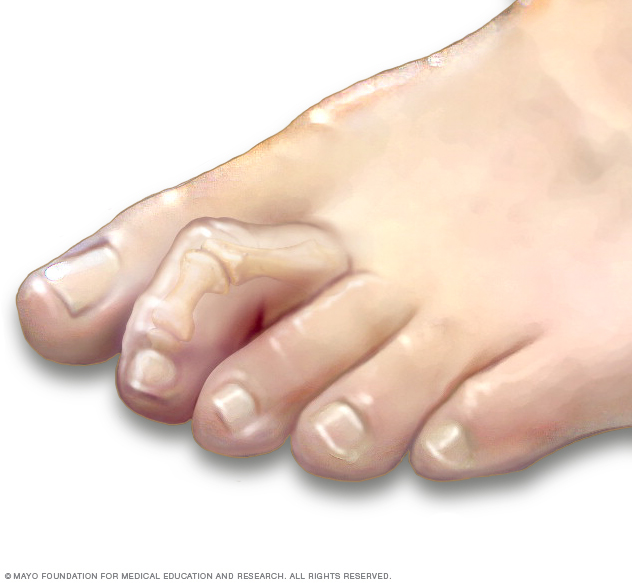A hammertoe can happen to anyone and is often associated with corns and calluses.
By Diana Rodriguez
Medically Reviewed by Niya Jones, MD, MPH
Hammertoe: What It Looks and Feels Like
“A hammertoe is a contracture of the toe at one of the two joints in the toe. Due to the pull of the tendons, the joints become more rigid over time. The toe is bent up at the joint and does not straighten out,” explains Alan K. Mauser, DPM, a podiatrist in Louisville, Ky.
A hammertoe appears bent in the middle, giving it a hammer-like appearance. The foot condition can cause pain, and make it even more difficult to move the toe.
“Hammertoe can happen on any toe, but it doesn’t happen on the big toe that often,” Dr. Mauser says. “Shoes will aggravate it, causing corns and pain. Sometimes you can get corns on the top of the toe because the toe is contracted, or corns on the tips of the toe which are very painful. Corns and hammertoes kind of go together.”
There are two main types of hammertoes. Hammertoes can be flexible, which means that you can still move the toe a bit — these are easier to treat with stretching, wider shoes and in some cases, toe splints. Rigid hammertoes occur when the foot condition has persisted for so long without treatment that the tendons become too rigid to be stretched back to normal. Rigid hammertoes are more common in people with arthritis. This foot condition usually needs to be treated with surgery.
What Causes a Hammertoe?
While ill-fitting shoes may contribute to a hammertoe, “shoes don’t [actually] cause it,” says Mauser. “Hammertoes occur by the pull and stretch of the tendon. One tendon gets a more mechanical advantage over the other and allows the deformity to occur.”
Not surprisingly, wearing shoes that are too tight can make a hammertoe worse. If you’re fond of narrow, pointy-toed shoes or high-heeled pumps, keep in mind you’re squeezing those toes and tendons, which may aggravate hammertoes.
Several other factors can play a role in the development of hammertoes, such as “biomechanical imbalances, arthritis, stroke, diabetes, and neuromuscular conditions,” notes Timothy C. Ford, DPM, director of the podiatric residency program at Jewish Hospital and St. Mary’s HealthCare in Louisville, Ky. Dr. Ford recommends that patients with hammertoe symptoms visit a podiatrist as soon as possible to determine the cause.
A simple foot injury, for instance, can also lead to a hammertoe — if you stub or break your toe, poor healing can result in a hammertoe. Additionally, hammertoes may run in families and can be inherited.
While there are a number of causes, there aren’t many specific risk factors for hammertoes, notes Mauser. “Women tend to get these problems more than men, but they occur without rhyme or reason,” he says. Diabetics, however, are more likely to get a hammertoe if they have underlying nerve damage in the toes and feet.



